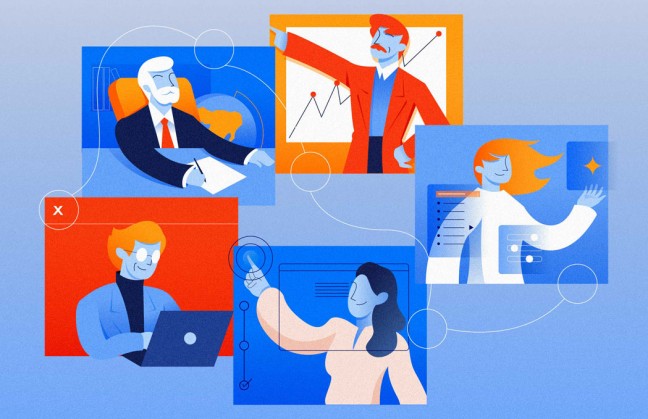Creating Generational Bridges in the Workplace
Generational diversity will define the workplace of the future. How can organizations learn to manage it?

In every corner of the world, human beings are now living longer than any previous generation. The outcome is that we are retiring later than ever, with the necessary conditions to perform our jobs properly. At work, we interact with colleagues who may be much older or much younger than us.
“Transition era” is a good way to describe the 21st century. From technology to the workforce, evolution has been drastic. For the first time in history, up to five generations coexist in companies, creating a multifaceted workforce. Seventy percent of organizations say leading multigenerational workforces is crucial for their success, according to Deloitte's 2021 Global Human Capital Trends survey. Nevertheless, only 10% are ready to tackle this trend.
As a result of the COVID-19 pandemic, ensuring employee well-being has become a key priority for multinationals and startups. However, with the arrival of Generation Z and the continuance of older generations, who are working beyond retirement age, companies and HR managers are finding it difficult to create a productive culture while balancing different perceptions.
Furthermore, companies understand that generational diversity will be significant in the workplace of the future and hierarchy management must be eradicated for their long-term survival. This adjustment has forced us to understand the desires, mindsets, and drivers of the intergenerational workforce in order to improve both management and results.
What is a generation?
In 2017, Kevin Clark clearly and precisely defined the so-called generational groups through his cohort theory: “A generation is defined as a group of individuals born and living contemporaneously who share common knowledge and experiences that affect their thoughts, attitudes, values, beliefs, and behaviors.” (Clark, 2017, p. 379)
What is the intergenerational workforce?
The convergence of employees from different generations –with different mindsets, ideologies and approaches— constitutes an intergenerational workforce. While this term was not prevalent in the past, it will undoubtedly be much more widely used in the workplace of the future.
For the first time ever, up to five generations will soon be working side by side. But whether this multi-generational workplace feels inspiring and productive or challenging and stressful, depends largely on the Human Resource departments. How should they connect with employees from different age groups? How can they motivate someone who is much older or much younger? And finally, what can HR do to encourage employees from different generations to collaborate and share their knowledge?
Which traits characterize each generation?
- Traditionalists (born approximately between 1922 and 1945)
Common traits: loyal, cautious, formal, proud.
Workplace influence: Most traditionalists are retired or about to retire, but their influence is prevalent in top-down organizational structures with clear reporting structures and a suit and tie uniform.
- Baby boomers (born approximately between 1946 and 1964)
Common traits: optimistic, self-focused, competitive, forever young.
Workplace influence: Until very recently, boomers comprised the largest workforce generation, creating more competition in the workplace as women and minorities began to take on jobs previously held only by white men in the traditionalist era.
- Generation X (born approximately between 1965 and 1980)
Common traits: independent, skeptical, digital pioneers.
Workplace influence: A generation almost as small in size as the traditionalists, members of Generation X feel pressure to perform from the boomers. While growing up, they were independent, self-sufficient, and supporting the technology that helped them, such as microwave ovens, video games, and personal computers.
- Millennials or Generation Y (born approximately between 1981 and 1997)
Common traits: self-expressive, group-oriented, global, technology-dependent.
Workplace influence: Also known as digital natives, many of today's young professionals grew up with the internet, which has a huge impact on the way they view the world and interact with others – texting and instant messaging versus face-to-face or phone communication, as well as the expectation that infinite information is just a click away.
- Generation Z (born from 1998 on)
Common traits (so far): cautious, technologically advanced, enterprising.
Workplace influence: 61% of high school students (Gen Z) state that they would rather be entrepreneurs than employees. This means that successful companies should start focusing on offering frequent rotational assignments and early leadership experiences to absorb this generation's entrepreneurial leanings.
As people work longer and delay retirement, internal career paths have changed. Organizational careers don't look the same as they used to. Seeing a younger person leading someone older is becoming increasingly common. This can cause tension on both sides. Perhaps there is a feeling of: why am I being led by someone who lacks experience? And, on the other hand, the younger person feels insecure and wonders: how do I do this?
Factors that hinder intergenerational collaboration
According to the 2021 Multigenerational Workforce Study, two-thirds of employees find it difficult to work with other age groups, and 40% prefer working with or being managed by colleagues from the same generation.
Despite the best intentions to express an orderly, collaborative work culture, companies are facing the “X-Y-Z” division syndrome, in which an intergenerational workforce is perceived as a negative factor, making it more difficult to build and maintain a suitable, productive workplace.
Intergenerational conflicts persist if organizations fail to foster and facilitate intergenerational awareness and understanding. Younger generations will view older employees' work styles as hierarchical, stubborn, and resistant to change, while underestimating their experience, expertise and wisdom.
In the same way, older generations will continue to regard young workers as overly sensitive, entitled, and overconfident, without appreciating their social mindset, digital literacy, and creativity.
If not addressed and resolved, these stereotypes can result in employee dissatisfaction, unhealthy rivalry, lack of mutual respect, low employee engagement, poor performance, slow-moving projects, and stalled innovation.
Which problems can arise from generational diversity in the workplace?
Since each generation has unique characteristics, things may not always be easy when the age gap is recognized. As an employer, it can be very difficult to handle the expectations of multi-generational employees – each generation has completely different expectations and priorities.
However, the first step in solving any potential challenges is to understand them:
- Risk of conflicts
Since each generation has distinctive traits and characteristics, there is a potential risk of conflicts occurring due to differing values and beliefs, work ethics and communication styles.
- Lack of mutual understanding
With multiple generations between them, it is not surprising that a boomer and a Gen-Z employee will collide and simply be unable to relate to each other.
- Different work styles
Each generation’s work style is different, and they are likely to clash from time to time. While boomers are comfortable working long hours and prefer to work in an office setting, Generations Y and Z prefer more flexible hours and the option to work remotely.
- Communication gaps
Not only do these generations have different work styles, but also different communication styles. This is largely due to technology, as each generation uses it to communicate in very different ways.
How can we improve intergenerational collaboration?
Unfortunately, generational differences are often ignored, hidden, or avoided. However, some organizations have strategies, initiatives, and programs to close the generational gap and foster a culture of intergenerational collaboration.
Here are some suggestions for promoting collaboration between generational cohorts:
1. Eradicate and avoid stereotypes
Since baby boomers and Gen Xers often disapprove of younger workers' sense of entitlement and lack of commitment, they fail to provide the necessary mentorship and guidance. Consequently, millennials and Generation Z feel ignored and unable to participate, blaming the previous generation's “old school” management approaches and viewpoints.
2. Understand and accept ideological differences
Young employees disapprove of their managers, and the boomer generation envy young people because they don't realize how strongly the behaviors or mindsets they disapprove of are in fact rooted in the historical, political, and social context that raised each generation.
3. Include bidirectional training and coaching
The fact remains that both generations, mature and young, have many more similarities than differences. However, the inclination towards information that validates a preconceived notion, combined with a lack of knowledge, creates chaos. Overcoming the mindset gap won’t happen overnight, but it will take us one step closer to the solution, with the right training.
4. Foster collaboration and constant development for every age group
With the constant tension between multiple generations in the workplace, healthy cooperation needs to be fostered between departments and employees of different age groups.
So, how can the mindset in intergenerational collaboration be changed?
Ninety percent of employees across all generations say that there is a lot they would like to learn from other age groups, and 99% state they want to find a way to work together positively.
When organizations are willing to address, acknowledge, explore, understand, and feel comfortable with generational diversity, they are genuinely helping their employees become aware of the strengths that shaped each generation.
- Implementing programs and initiatives with knowledge sessions, training, coaching, seminars, coworking spaces, and team bonding events helps to foment intergenerational awareness.
- Using multigenerational matrix teams or shadow boards promotes intergenerational collaboration.
- Teach the intergenerational workforce to capitalize on the skills of each generation in order to meet diverse organizational needs.
- Companies can achieve effective teamwork and cooperation by having two-way conversations where everyone learns and appreciates the value others bring to the workplace.
- Create an informal or formal environment where the team members with experience in specific areas can conduct internal training.
Promoting generational diversity in the workplace can benefit companies in several ways. Employees from different generations offer unique perspectives and bring different strengths to the table.
- Problem Solving: Since each generation has a different approach to problem solving, having a multigenerational workforce can be highly beneficial when it comes to identifying potential solutions and new ways of tackling everyday problems.
- Understanding different audiences: Each generation is unique, which is a great asset for organizations. Employing people from each generation provides greater insight into the different target audiences they are endeavoring to reach.
- Learning opportunities: Generational diversity in the workplace offers learning opportunities for all employees, not just the youngest. Across the generations, employees can teach each other new ways of approaching things and more efficient ways of doing business.
- Mentoring: A multi-generational workforce is the perfect setting for mentoring. Many organizations choose to start a mentoring program to give employees the chance to educate each another. Not only does this help employees acquire new skills and information, but it also improves the way they work together.
While generational diversity in the workplace is a challenge for employers and employees, it can also be a strong competitive advantage for the companies that embrace it. A significant number of organizations have intergenerational mentoring programs that benefit mentors and mentees alike. Such programs serve to increase workplace diversity and inclusion.
By fostering a culture that promotes collaboration, keeping lines of communication open, and adapting their approach to each individual, companies can anticipate any potential conflict before it arises and reap all the benefits of a multigenerational workforce.
The author is Full-Time Professor, Department of Strategy and Leadership, EGADE Business School.



